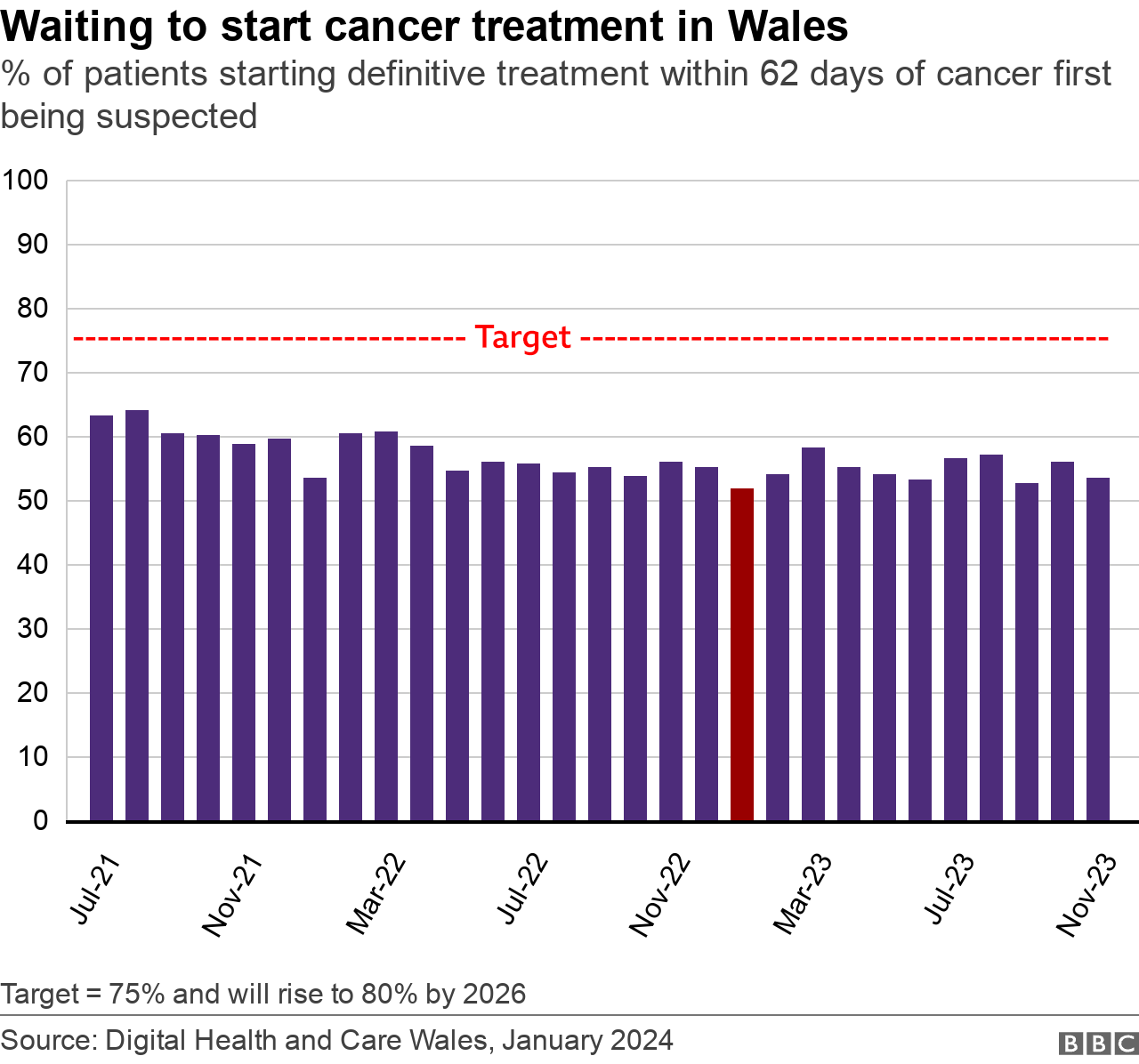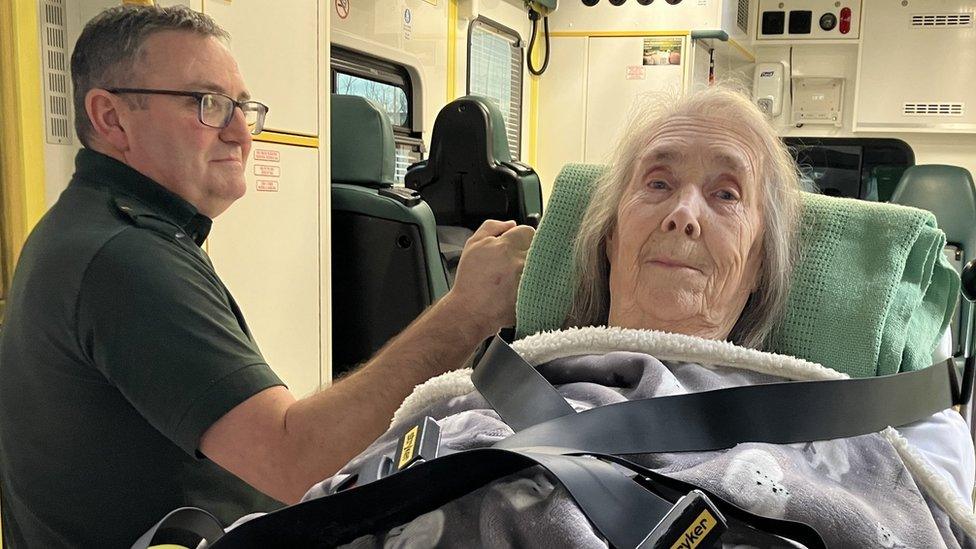NHS Wales: Hospital waiting times fall after eight months
- Published

The health minister said good progress was being made in cutting delayed discharges of patients who were well enough to go home
Wales' hospital waiting times have dropped after rising to record levels over the previous eight months.
A&E units and ambulance performance also fared better compared to December 2022's record winter pressures.
Health minister Eluned Morgan said the NHS had "coped relatively well under difficult circumstances so far this winter".
The unadjusted figure shows 758,815 patient pathways, with some people waiting on more than one list.
It is estimated that 582,000 individuals are waiting, with an average time of more than 20 weeks.
Cancer waiting times have worsened, with 53.5% of new patients starting treatment within 62 days of cancer being first suspected.
Glenn Page, Macmillan policy manager for Wales said this was "woefully short" of what was needed.
Cancer Research UK added: "NHS staff are working incredibly hard but years of chronic workforce shortages and a lack of specialist facilities means the system can't cope."

The 758,815 patient pathways is down by more than 3,200 on the month.
We can look at just consultant-led specialisms, which enables us to compare more easily with England, and this shows 674,120 patients waiting.
Of these, 20.2% -136,151 patients - are waiting more than a year in Wales, compared to only 4.7% of people in England.
There were also 24,779 patients in these consultant-led specialisms waiting two or more years.
NHS England has got these longest waits down to just 227 people.

A&E waiting times have improved for the second month in succession.
There were 69.9% of patients waiting four hours or less for admission, transfer or discharge.
The average waiting time was two hours and 52 minutes, more than 11 minutes slower than the previous month.
When major A&E units were compared to their equivalent in England, then performance in Wales was better for a fourth consecutive month.
The target - never met in Wales - is that 95% of patients should wait no more than four hours.
There were also 9,635 patients waiting more than 12 hours - when the target is that no-one should wait this long.
This is up on last month but more than 2,400 fewer than record numbers we saw a year ago.
The Royal College of Emergency Medicine in Wales , externalcriticised the lack of a winter plan, as staff faced extremely challenging conditions.
"It is hugely distressing for our members to care for and witness patients, particularly the elderly and most vulnerable, face extended wait times," said Dr Rob Perry, vice president.
"It is no wonder our workforce is burnt-out and demoralised."

Only 48.9% of the most life-threatening "red" ambulance calls arrived within the eight minute target time - slightly worse than the month before but better than a year ago, when they hit a record low.
There are now more than twice as many calls graded red than in 2017. The average response time was eight minutes and eight seconds, nearly two minutes faster than a year ago.
Meanwhile, there were 22,572 "lost hours" - the time ambulances spent outside A&E waiting to hand over patients beyond a 15-minute window.
This was worse than last month but more than a quarter down on December 2022, when they hit a record.
There was also a drop in the number of patients fit enough to be discharged from hospital although unable to leave because support at home or in the care sector was not available.

Conservative health spokesman Russell George said: "It is atrocious that two key services provided by our Welsh NHS, cancer and ambulance waits, are worsening yet again in Labour-run Wales."
The NHS Confederation, which represents health boards in Wales, said: "What's clear from these figures is that, despite NHS leaders planning all year for the difficult winter months and ramping up levels of activity, the NHS is unable to keep pace with the significant levels of demand from the higher acuity of patients' conditions in winter in particular, with the resource available."
The Royal College of Surgeons said a survey of members in Wales found nearly two thirds were finding accessing operating theatres a major challenge.
"Waits have been fluctuating between rising and falling for a number of months now, and we haven't seen a significant or sustained fall for some time," said Prof Jon Barry, its director in Wales.
"If surgical teams cannot get into operating theatres, patients will continue to endure unacceptably long waits for surgery."
Ms Morgan said: "I am delighted that, for the first time in a number of months, the overall number of people on waiting lists has come down, but the challenging winter we have been through means that this may be difficult to sustain over the coming months.
"But there is much more to be done and we will continue to work with health boards to tackle the longest waits."

Compared to last December, today's NHS performance figures show an improved picture for emergency care during what is typically the most challenging period of the year.
Ambulance response times in particular are better - and while demand was still particularly high, it wasn't as high as a year ago.
But this winter hasn't seen the peaks of seasonal illnesses like flu and Covid that made December 2022 so tough, therefore direct comparisons will always involve some heavy caveats.
And we must remember that these figures are nowhere near the targets.
Targets have been set to eliminate "most" two year waits by March 2023, though there are still more than 3,000 in that category and a further 21,000 not included.
Likewise a target to eliminate the numbers waiting more than a year for their first outpatient appointment have not been met, nearly a year after the deadline.
Indeed, those increased to about 53,900.
The final point of context for planned care is that in any improvement seen here for November will likely be impacted by industrial action by junior doctors in January.


Related topics
- Published21 December 2023

- Published18 December 2023

- Published23 November 2023

- Published19 October 2023
